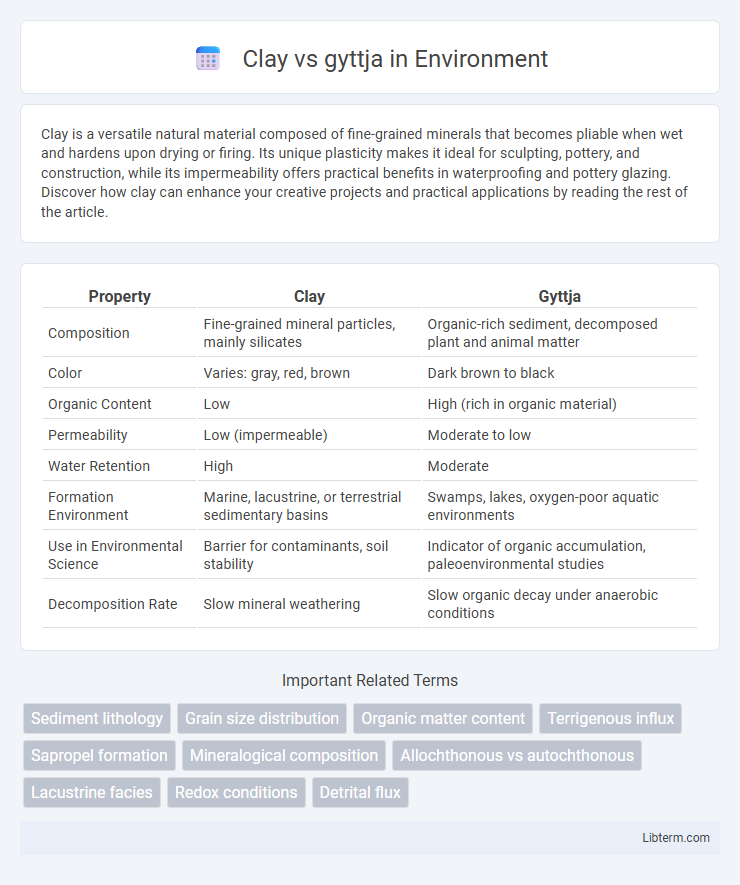Clay is a versatile natural material composed of fine-grained minerals that becomes pliable when wet and hardens upon drying or firing. Its unique plasticity makes it ideal for sculpting, pottery, and construction, while its impermeability offers practical benefits in waterproofing and pottery glazing. Discover how clay can enhance your creative projects and practical applications by reading the rest of the article.
Table of Comparison
| Property | Clay | Gyttja |
|---|---|---|
| Composition | Fine-grained mineral particles, mainly silicates | Organic-rich sediment, decomposed plant and animal matter |
| Color | Varies: gray, red, brown | Dark brown to black |
| Organic Content | Low | High (rich in organic material) |
| Permeability | Low (impermeable) | Moderate to low |
| Water Retention | High | Moderate |
| Formation Environment | Marine, lacustrine, or terrestrial sedimentary basins | Swamps, lakes, oxygen-poor aquatic environments |
| Use in Environmental Science | Barrier for contaminants, soil stability | Indicator of organic accumulation, paleoenvironmental studies |
| Decomposition Rate | Slow mineral weathering | Slow organic decay under anaerobic conditions |
Introduction to Clay and Gyttja
Clay is a fine-grained natural soil material composed mainly of minerals like kaolinite, illite, and montmorillonite, characterized by its plasticity and ability to retain water. Gyttja is an organic-rich sediment formed from the partial decay of aquatic plants and microorganisms, commonly found in lake bottoms and peatlands. Both materials differ in composition, with clay primarily inorganic and gyttja containing high organic content, influencing their physical and chemical properties.
Defining Clay: Composition and Properties
Clay is a fine-grained natural soil material composed mainly of hydrous aluminum silicates, such as kaolinite, illite, and montmorillonite, known for its plasticity when wet and hardness upon drying. Its particle size typically measures less than 2 micrometers, which allows high cohesion, low permeability, and significant water retention. These properties distinguish clay from gyttja, which is an organic-rich sediment primarily formed from decayed plant material and has a higher organic content and lower mineral fraction.
Understanding Gyttja: Origin and Characteristics
Gyttja is a soft, organic-rich sediment formed in anaerobic lake or wetland environments through the decomposition of plant material and microorganisms, distinguishing it from mineral-dominated clay. Its high organic content and dark coloration indicate reducing conditions, resulting in low density and high water retention. Understanding gyttja's origin and characteristics is crucial for applications in paleoenvironmental studies and sedimentology.
Geological Formation Processes
Clay forms through the chemical weathering of silicate minerals, resulting in fine-grained particles rich in aluminum silicates that accumulate in low-energy environments. Gyttja originates from the anaerobic decomposition of organic material in freshwater sediments, leading to an organic-rich, soft mud typically found in lake bottoms. The primary geological difference lies in clay's mineral-based genesis versus gyttja's biogenic accumulation under oxygen-poor, water-saturated conditions.
Physical and Chemical Differences
Clay consists primarily of fine mineral particles less than 0.002 mm in size, characterized by high plasticity, low permeability, and a predominance of silicate minerals such as kaolinite and montmorillonite. Gyttja is an organic-rich mud formed from the decomposition of aquatic plants and sediments, exhibiting higher organic carbon content and generally lower bulk density compared to clay. Chemically, clay has a higher concentration of aluminosilicates, whereas gyttja contains more organic matter and reduced mineral content, influencing differences in nutrient availability and redox conditions.
Environmental Occurrence: Where Are They Found?
Clay is predominantly found in soil and sedimentary environments, especially in river valleys, lake beds, and marine basins where fine mineral particles accumulate. Gyttja occurs mainly in anoxic lake sediments rich in organic material, formed from the partial decomposition of plant matter under low oxygen conditions. Both materials commonly coexist in wetland and lacustrine settings but differ in composition and formation processes.
Applications and Uses in Industry
Clay's fine particles and plasticity make it ideal for ceramics, bricks, and cement industries, providing structural strength and water resistance. Gyttja, rich in organic matter and formed in freshwater sediments, is utilized in agriculture as a nutrient-rich soil conditioner and in environmental engineering for pollution remediation. Both materials serve crucial roles in geotechnical applications, with clay offering foundational support and gyttja aiding in residue management and land reclamation.
Impact on Soil and Water Quality
Clay particles, due to their fine texture and high surface area, significantly influence soil structure and water retention, often leading to reduced permeability and potential waterlogging. Gyttja, an organic-rich sediment formed in aquatic environments, enhances soil fertility by supplying essential nutrients and improving soil aeration and microbial activity. The contrasting properties of clay and gyttja directly affect soil drainage, nutrient availability, and water quality, shaping the ecological balance in terrestrial and aquatic systems.
Challenges in Identification and Classification
Clay and gyttja present significant challenges in identification and classification due to their overlapping physical and chemical properties, such as fine particle size and organic content. Distinguishing between mineral-rich clay and organic-rich gyttja requires detailed analysis using techniques like X-ray diffraction or organic carbon measurement. Variability in depositional environments further complicates classification since transitional sediments often exhibit mixed characteristics.
Conclusion: Choosing Between Clay and Gyttja
Choosing between clay and gyttja depends on the specific application, as clay offers excellent plasticity and fine particle size ideal for pottery and construction, while gyttja's organic-rich composition makes it valuable for paleoenvironmental studies and sediment analysis. Clay's mineralogical stability provides durability and load-bearing capacity, whereas gyttja's high water content and organic matter influence its geotechnical properties, limiting its use in structural applications. Understanding the mineral content, mechanical behavior, and environmental context ensures the optimal selection of either clay or gyttja for engineering, environmental, or archaeological projects.
Clay Infographic

 libterm.com
libterm.com